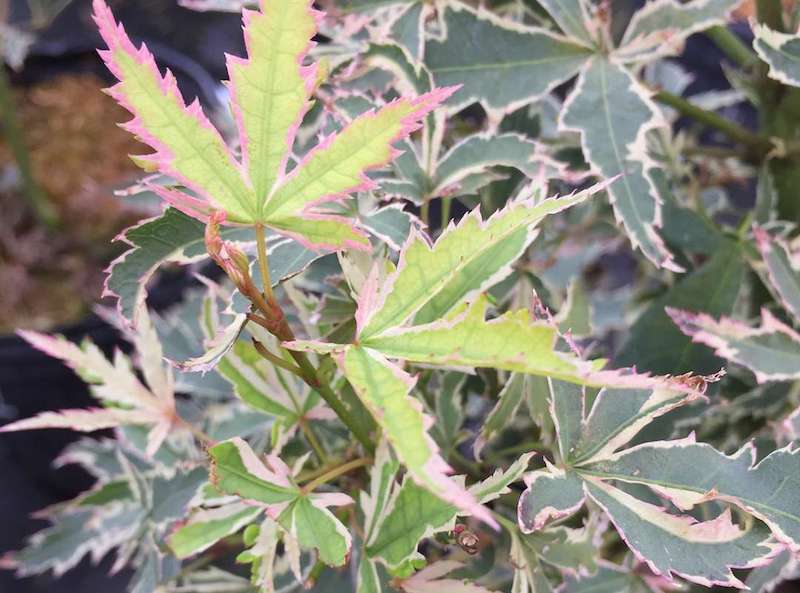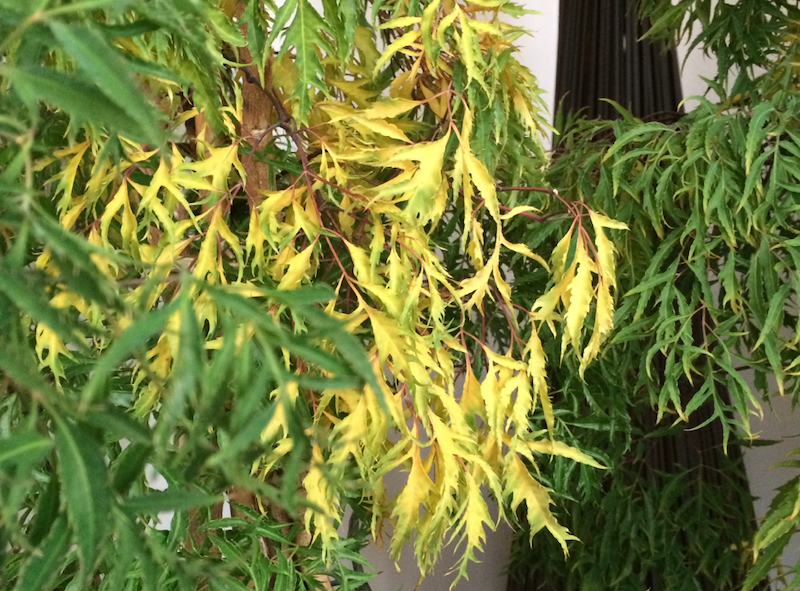Japanese maples, Acer palmatum, are low-maintenance trees that are suited for many home gardens. While they are easy to grow, these trees are occasionally affected by diseases that may harm the plant’s aesthetics or health. The most common diseases of Japanese maples are anthracnose, leaf scorch, powdery mildew, root rot, and Verticillium wilt. Prevention is the best line of defense for many of these conditions.

Anthracnose
Anthracnose in Japanese maples is caused by several fungal pathogens such as Aureobasidium and Colletotrichum. In most cases, this disease is only cosmetic and does not negatively affect the health of the plant. In extreme infections, defoliation and shoot dieback may occur, notably in spring right after the Japanese maple leafs out. Initial spring defoliation is usually followed by a second flush of fresh growth. Younger trees are more susceptible to severe damage than older, established trees.
Anthracnose is prevalent in spring through summer. Spores favor cool or warm, wet conditions to spread and infect Japanese maples. They will overwinter on dead leaves and twigs from infected plants. Once spring arrives, the spores travel by water or wind to infect live Japanese maples. Mild springs with plenty of rainfall will often result in greater anthracnose pressure.
Identifying Anthracnose
On Japanese maples, Anthracnose can be identified as creamy or tan-colored, angular blotches on the leaf margins and veins. Touching the blotches will reveal that the tissue is dead and crunchy in texture. Upon closer inspection, tiny black spores will be present on the blotches, indicating the presence of the fungal pathogen.
Treating Anthracnose
Prune out any infected branches or shoots. Remove any fallen leaves or twigs from Japanese maples that have been previously infected with anthracnose, as the spores will overwinter in the dead material. Younger and stressed trees are more prone to infection and long-term damage. Reduce sources of environmental stress to your tree by fertilizing once in the spring, watering during dry periods, and controlling insect pests as needed. In severe cases, chemical controls may be warranted. Use a fungicide labeled for control of anthracnose on maples. Apply the fungicide before the tree leafs out in early spring.
Leaf Scorch
Leaf scorch is a physiological disease of Japanese maples. It is not caused by any pathogens; rather, it is due to a lack of water. Leaf scorch is more likely to occur during hot, dry periods. Trees planted in full sun are more often affected. Leaf scorch is almost never harmful to healthy Japanese maples, and the trees will recover nicely with proper care and future prevention.
Identifying Leaf Scorch
Leaf scorch presents as tan-to-brown, dry leaf margins and tips. There will be no signs of pathogens, such as spores, present on the necrotic tissue.
Treating Leaf Scorch
Prevent leaf scorch by watering your Japanese maple well. Deeply water the tree whenever precipitation has been scarce and the soil is dry or cracked. Newly planted Japanese maples should be watered every few days to once per week for the first 2 or 3 growing seasons. Apply 1-3 inches of mulch above the roots to conserve soil moisture, avoiding contact with the trunk. Always water your Japanese maple after applying fertilizer in the spring to prevent additional damage from fertilizer burn. Consider transplanting your Japanese maple to a shadier location if you are able to do so.
Powdery Mildew
Many genera of fungi cause powdery mildew on Japanese maples, namely Phyllactinia and Sawadaea. Powdery mildew spreads by wind and does not need water to infect plants. This disease overwinters on plant debris in the soil. The spread of powdery mildew is favored by mild temperatures and relatively high humidity at night. Infection usually occurs in mid to late summer through fall. Early senescence and defoliation of the leaves in the fall are typical in severe infections. Powdery mildew is mostly an aesthetic disease and is rarely fatal to plants.
Identifying Powdery Mildew
As the name suggests, powdery mildew looks like white, dusty growth on the surfaces of leaves. Black fruiting bodies will be present on the underside of infected leaves.
Treating Powdery Mildew
Unlike many other fungal pathogens, powdery mildew can infect plants in dry conditions. That being said, air circulation is important for prevention. Prune out any overlapping, dead, or damaged branches on your Japanese maple. Space your Japanese maples 6-20 feet apart depending on the mature height and spread of the tree. Rake away all fallen leaves from infected Japanese maples to prevent the pathogen from overwintering. Chemical control may be necessary for young, newly planted, or stressed trees. Use a registered fungicide per label instructions.
Root Rot
Root rot in Japanese maples is usually caused by the oomycetes Phytophthora or Pythium. These fungus-like pathogens thrive in overly wet conditions caused by poor drainage, flooding, or excessive irrigation. The first symptoms of root rot in Japanese maples resemble physiological conditions, such as nutrient deficiencies or watering issues. Slowed growth and yellowed or blackened leaves are common symptoms. Next, branch and root dieback will be evident, eventually followed by the death of the entire tree. Root rot pathogens can survive in the soil of infected plants and on infected plant matter for long periods of time.
Identifying Root Rot
Root rot is recognized by decaying tissue at the soil line and in the roots. The vascular cambium - the tissue between the bark and the wood - is also affected. When the bark near the lower trunk is peeled back, the vascular cambium will appear brown and mushy, rather than its usual green color.
Treating Root Rot
The best way to combat root rot is through prevention. Do not plant Japanese maples in low-lying areas where water frequently pools following precipitation, and amend heavy clay soils with organic matter at planting time. Only water your Japanese maple when the soil is dry. Avoid volcano mulching, which is when mulch is applied against the trunk of the tree. Remove and destroy any plants affected by root rot. Registered fungicides may also be used, but they mainly work as preventatives rather than cures.
Verticillium Wilt
Verticillium wilt is a soil-borne fungal pathogen of Japanese maples and many other woody plants. This disease blocks the vascular system of Japanese maples, interrupting or preventing the flow of water. Severity varies based on where the Verticillium fungus has colonized. When the newer wood is affected, the onset of symptoms is more sudden and quick. If older wood is affected, symptoms appear gradually, affecting just a few branches at a time until the entire tree is affected.
Verticillium can survive in the soil for over a decade. This fungus can stay dormant in the soil for many years before it enters the plant. It is difficult to detect or eradicate from the soils that it inhabits. Verticillium usually enters Japanese maples via wounds on the roots. It does not spread by water or wind. This pathogen can infect trees at any time of the year but is usually favored by the hot, dry conditions of summer.
Identifying Verticillium Wilt
Verticillium fungus lives in the xylem tissue of infected Japanese maples. This causes wilting, yellowing or browning of leaf tissue, branch dieback, stunted growth, and early leaf drop. Often, a larger crop of fruit, called samaras, is produced when the older wood is affected. In severe cases, entire trees may die. These symptoms may often mimic other diseases or conditions; send samples to your local extension’s plant disease clinic to confirm the diagnosis.

Treating Verticillium Wilt
There is no way to cure a Japanese maple that has been infected with Verticillium wilt. Healthy, established trees may survive with proper care, especially if just the old wood is affected. Water your Japanese maple deeply during drought periods and apply slow-release fertilizer in the spring. Regularly prune out any dead, pest-ridden, damaged, or crossing branches. Mulching will also keep the tree healthy.
Do not mow over the Japanese maple’s roots. Although wounds occur naturally on roots as they grow, it is best to steer clear of unnecessary injury. This will avoid added stress to the plant while also avoiding additional areas of entry for this fungal pathogen. Remove dead or severely infected trees and replace them with trees that are resistant to Verticillium wilt, such as conifers.
Japanese Maple Disease Chart
|
Disease |
Identifying |
Treating |
|
Anthracnose |
Irregular brown blotches on leaves, defoliation and dieback |
Prune and remove infected branches and fallen leaves, apply fungicides |
|
Leaf Scorch |
Dry, brown leaf margins |
Water deeply when soil is dry, apply mulch |
|
Powdery Mildew |
Powdery growth on leaf surface |
Improve air circulation, remove infected leaves and twigs, apply fungicides |
|
Root Rot |
Decaying, mushy roots and vascular cambium, dieback, death of tree |
Improve soil drainage, do not overwater, remove infected trees |
|
Verticillium Wilt |
Wilting, dieback, leaf drop, death of tree |
Nurture trees to improve vigor, avoid wounding roots, replace infected trees with resistant plants |
Sources:
"Common Diseases of Maple." Connecticut State - The Connecticut Agricultural Experiment Station. portal.ct.gov
"Maple—Acer spp." University of California Integrated Pest Management. ipm.ucanr.edu
 |
Lauren Youngcourt - Published 05-03-2023 |
